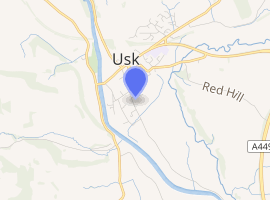Sessions House, Usk
The Sessions House at Usk, Wales, is a Victorian courthouse by Thomas Henry Wyatt of 1877.[1] The building was opened by Samuel Richard Bosanquet, of Dingestow Court, then Chairman of the Monmouthshire Quarter Sessions.[2] It is a Grade II* listed building as of 4 January 1974.[3]
| Sessions House | |
|---|---|
 | |

| |
| General information | |
| Status | Grade II* listed |
| Town or city | Usk |
| Country | |
| Coordinates | 51.7001°N 2.9010°W |
| Construction started | 1875 |
| Completed | 1878 |
| Client | Monmouthshire Quarter Sessions |
| Design and construction | |
| Architect | Thomas Henry Wyatt |
The court is of mauve sandstone with dressings of Bath stone.[1] It is of five bays, with a cornice, parapet[4] and balustraded terrace.[3] It originally contained two courtrooms but Court Number 1 was gutted by fire in 1944 and was not re-built.[2] Court Number 2 "survives little altered."[1] "There is an impressive judge’s chair and the benches retain their original labels for Counsel, Solicitors, Reporters, Jury etc."[2] A passage under the dock leads through to Usk Prison which stands next door.[2]
The Sessions House saw two major nineteenth century trials: those of Margaret Mackworth, 2nd Viscountess Rhondda,[2] a prominent suffragette; and of Josef Garcia, a Spanish seaman, who was tried and convicted of the murder of William and Elizabeth Watkins of Llangybi and of their three youngest children Charlotte, Alice and Frederick in 1878.[2]
The building was purchased by Usk Town Council to mark the Millennium, and it is now used as the town hall and for community use.
Notes
- The Buildings of Wales: Gwent/Monmouthshire, p. 593
- "Sessions House". Usktown.co.uk. 2008-12-12. Archived from the original on 2012-03-11. Retrieved 2012-02-12.
- Good Stuff IT Services (1974-01-04). "The Sessions House including balustraded terrace. – Usk – Monmouthshire – Wales". British Listed Buildings. Retrieved 2012-02-12.
- "Maryport Street, Sessions House, Usk | Site Details". Coflein. Retrieved 2012-02-12.
External links
Bibliography
- John Newman, The Buildings of Wales: Gwent/Monmouthshire, p. 593 ISBN 0-14-071053-1